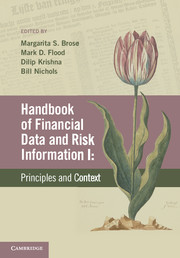Book contents
- Frontmatter
- Contents
- List of contributors
- Preface
- VOLUME I: PRINCIPLES AND CONTEXT
- PART I RISK MANAGEMENT CONTEXT FOR FINANCIAL DATA
- 1 A brief history of financial risk and information
- 2 Risk management
- 3 Portfolio risk monitoring
- 4 Frameworks for systemic risk monitoring
- 5 Data-driven regulation and financial reform: one perspective from industry on the financial crisis
- PART II REQUIREMENTS AND SOURCES FOR FINANCIAL RISK MANAGEMENT
- PART III REGULATORY DATA
- Index – Volume I
- References
3 - Portfolio risk monitoring
from PART I - RISK MANAGEMENT CONTEXT FOR FINANCIAL DATA
- Frontmatter
- Contents
- List of contributors
- Preface
- VOLUME I: PRINCIPLES AND CONTEXT
- PART I RISK MANAGEMENT CONTEXT FOR FINANCIAL DATA
- 1 A brief history of financial risk and information
- 2 Risk management
- 3 Portfolio risk monitoring
- 4 Frameworks for systemic risk monitoring
- 5 Data-driven regulation and financial reform: one perspective from industry on the financial crisis
- PART II REQUIREMENTS AND SOURCES FOR FINANCIAL RISK MANAGEMENT
- PART III REGULATORY DATA
- Index – Volume I
- References
Summary
This chapter reviews the building blocks for an effective portfolio risk monitoring capability, emphasizing the reporting and governance elements needed for successful risk tracking within a financial firm. To motivate the discussion and provide consistency throughout, the focus is on monitoring a mortgage portfolio, realizing that the monitoring function spans across assets, liabilities, business lines and risk types. However, the general lessons presented here apply to a broad range of portfolio types, including equities, fixed income, derivatives, etc.
What is portfolio risk monitoring?
Performance monitoring is a risk manager's primary tool for understanding the quality of the risk profile of a portfolio and must be viewed as a dynamic process as economic and market conditions and obligor risk profiles change over time. Such a process must be tailored to the specific features of the portfolio and so requires a high degree of customization. For example, designing an asset-liability management (ALM) monitoring framework might entail development of interest rate shock scenarios against which the portfolio would be measured in terms of market value changes, and/or include a value-at-risk (VaR) analysis of individual asset types such as equities, foreign exchange exposures and fixed income positions. As a guidepost to developing such capabilities, the portfolio manager must determine the audience for the results and the timelines required for each reporting deliverable.
- Type
- Chapter
- Information
- Handbook of Financial Data and Risk Information IPrinciples and Context, pp. 75 - 104Publisher: Cambridge University PressPrint publication year: 2014



